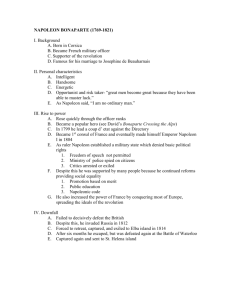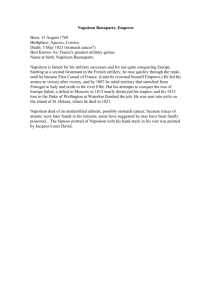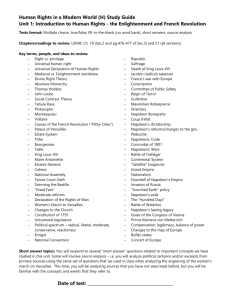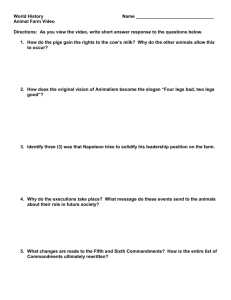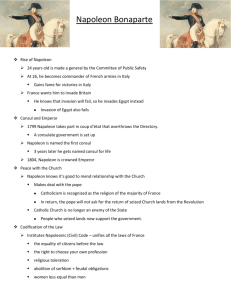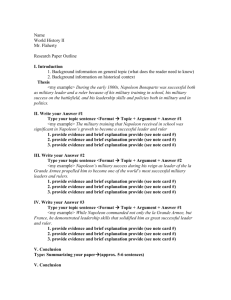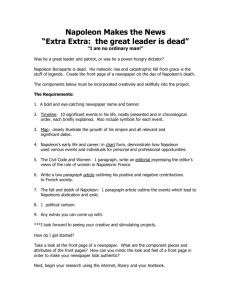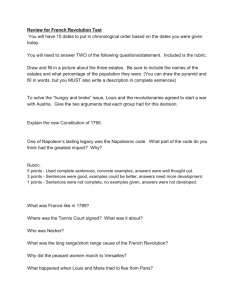6. Napoleon's Europe
advertisement
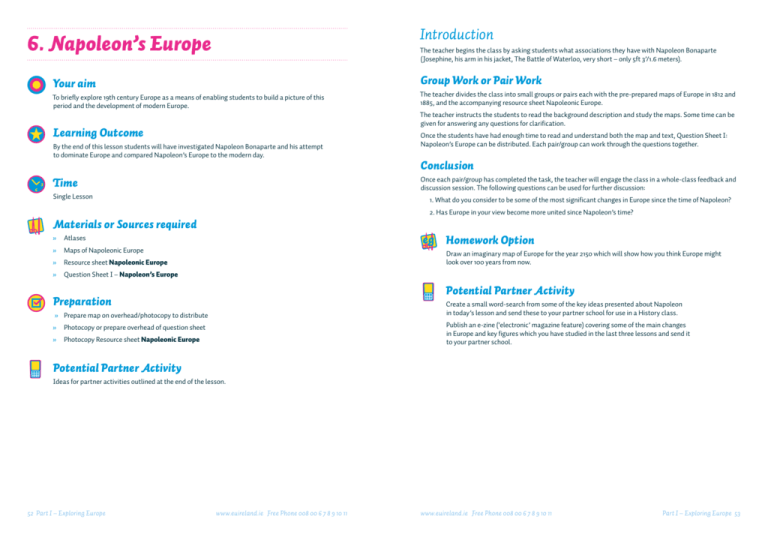
Introduction 6. Napoleon’s Europe The teacher begins the class by asking students what associations they have with Napoleon Bonaparte (Josephine, his arm in his jacket, The Battle of Waterloo, very short – only 5ft 3’/1.6 meters). Group Work or Pair Work Your aim To briefly explore 19th century Europe as a means of enabling students to build a picture of this period and the development of modern Europe. Learning Outcome By the end of this lesson students will have investigated Napoleon Bonaparte and his attempt to dominate Europe and compared Napoleon’s Europe to the modern day. 6 3 The teacher instructs the students to read the background description and study the maps. Some time can be given for answering any questions for clarification. Once the students have had enough time to read and understand both the map and text, Question Sheet I: Napoleon’s Europe can be distributed. Each pair/group can work through the questions together. Conclusion Once each pair/group has completed the task, the teacher will engage the class in a whole-class feedback and discussion session. The following questions can be used for further discussion: Time Single Lesson The teacher divides the class into small groups or pairs each with the pre-prepared maps of Europe in 1812 and 1885, and the accompanying resource sheet Napoleonic Europe. Materials or Sources required 1. What do you consider to be some of the most significant changes in Europe since the time of Napoleon? 2. Has Europe in your view become more united since Napoleon’s time? Homework Option » Atlases » Maps of Napoleonic Europe Draw an imaginary map of Europe for the year 2150 which will show how you think Europe might look over 100 years from now. » Resource sheet Napoleonic Europe » Question Sheet I – Napoleon’s Europe Potential Partner Activity Preparation Create a small word-search from some of the key ideas presented about Napoleon in today’s lesson and send these to your partner school for use in a History class. » Prepare map on overhead/photocopy to distribute Publish an e-zine (‘electronic’ magazine feature) covering some of the main changes in Europe and key figures which you have studied in the last three lessons and send it to your partner school. » Photocopy or prepare overhead of question sheet » Photocopy Resource sheet Napoleonic Europe Potential Partner Activity Ideas for partner activities outlined at the end of the lesson. 52 Part I – Exploring Europe www.euireland.ie Free Phone 008 00 6 7 8 9 10 11 www.euireland.ie Free Phone 008 00 6 7 8 9 10 11 Part I – Exploring Europe 53 Resource Sheet: Question Sheet I: Napoleonic Europe Napoleon’s Europe Following the death of Charlemagne in 814 his empire was weakened by attacks and split between 3 grandsons; although the title of Holy Roman Emperor survived in some form until 1806. Using the maps and background information take time to consider the following questions and prepare your answers The reign of Napoleon Bonaparte, Emperor of the French in the early 19th century saw a major transformation in the shape of Europe’s borders. Napoleon had been born on the island of Corsica, and rose to power through the French army in the period of the French Revolution when the new rulers believed in egalitarianism and careers opened by talent. The French started fighting a defensive war to prevent attack from other European countries (e.g. Britain, The Holy Roman Empire and Austria). These countries were horrified by what had happened in France (especially the execution of the King and Queen) and were in league with some French aristocratic émigrés who wanted to re-establish the ‘ancien regime’ as it had been before the French Revolution. Napoleon was given leadership of the French army at the age of 27 and he gradually fought and defeated all possible threats to the new French Republic. He defeated the Austrians, various German states, Switzerland, Poland and Russia in a glorious series of battles throughout the 1790s. He then went on to force submission from many of these states and set up new puppet states on the style of France, but with various members of Napoleon’s family in control and thus assuring their dependence on France. His brothers Joseph (Spain), Jerome (German state of Westphalia) and Louis (Holland) all became rulers in these conquered territories. He was never successful against the British, despite his attempt to attack them through their interest in Egypt; and when he tried to invade Russia in 1812 and was forced to retreat, it was the beginning of the end. Meanwhile, at home he had moved from the military into the political sphere. He seized power over the country in 1799, while the French Government was going through a difficult period. He established a Government of 3 consuls and claimed the most powerful position as First Consul for himself. By 1804 he had dispensed with the other consuls and made himself Emperor. He had great ambition, imagination, energy and intelligence and he worked tirelessly to reorganise the administration of France. This included local government, taxes, banking, laws, education and new decimal system of weights and measurements. These new ideas were also applied in the states under the control of France. Some of the peoples of these occupied lands, who initially had been glad to be rid of the old monarchies, realised that they had simply swapped one monarch for another and this sparked off a nationalist fervour in the later wars where many fought to defeat Napoleon. The French had preached the new message of ‘fraternity’ and now the defeated people used it to unite their own people against them. Napoleon was eventually defeated at the famous Battle of Waterloo, after a coalition of European powers had banded together against him. He was exiled on the island of St Helena, and the monarchy was restored in France. During the rest of the nineteenth century the nationalist feeling that had been ignited by the fight against the French rule continued to grow and came to transform the map of Europe in the late nineteenth and early twentieth century. 54 Part I – Exploring Europe www.euireland.ie Free Phone 008 00 6 7 8 9 10 11 1. Describe Europe in 1812, outlining which countries are under French control and which are not. 2. In each of the maps studied so far Ireland has not been part of a major European Empire. Why do you think this is so? 3. In the 1885 map how many different empires can you identify? 4. What modern day countries have taken on their present day shape by 1885? 5. What 2 nation states which were not unified in 1812 have now achieved unity? 6. List three modern day countries which were not independent states in 1885. In each case say which other European country is ruling over them. 7. Can you identify three countries which were not independent in 1812, but which had achieved independence by 1885? Do these countries still exist today as independent countries? www.euireland.ie Free Phone 008 00 6 7 8 9 10 11 Part I – Exploring Europe 55
